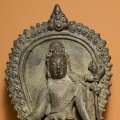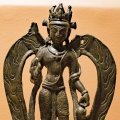Patan Museum (Nepal): photo 99
Photo 99 of 212 in Gallery: Patan Museum (Nepal)

Image title: Avalokiteshvara (12th century)
Description of the photo
This Bronze sculpture shows an image of Avalokiteshvara, from the 12th century origination from Western Himalayas.—Materials used: Bronze, silver inlay.
Notes: These objects represent some of the finest and earliest bronze sculptures in the Patan Museum. All depict bodhisattvas, enlightened beings. They were made in the 11th or 12th century in various regions on the periphery of Nepal. All the sculptures in this case were probably brought into Nepal by Buddhist pilgrims. Those from the Pala domain, in what is now northern India and Bangladesh, then ruled by fervent supporters of Buddhism, were very influential in shaping the Nepalese artists’ vision of divine imagery.
Gallery information:
The Patan Museum is located on the Durbar square of Patan (Lalitpur/Lalitapura, Kathmandu, Nepal) which is associated Keshav Narayan Chowk (Keshavnarayan)—a form of Lord Vishnu. Being listed as a World Heritage Site, the whole of Durbar square is filled with exquisite temples, sculptures and other ancient structures, of which the ancient history history can be traced to the Malla Kings of Lalitpur. It is an important site for both Buddhism and Hinduism.
Photo details:
Date: 2019-12-02
Camera: SONY ILCE-6400
Exposure: 1/40
Aperture: f/4.5
ISO: 100
Focal length: 37mm
High resolution:
Download file
Size: 1.55 MB
Resolution: 1248 x 2372
© Photograph by Gabe Hiemstra.
License: CC BY-NC-ND 4.0

